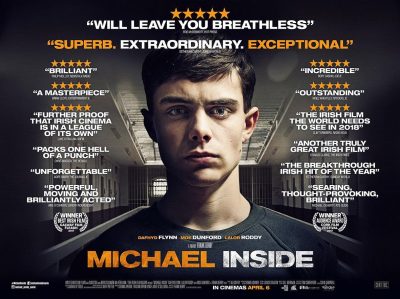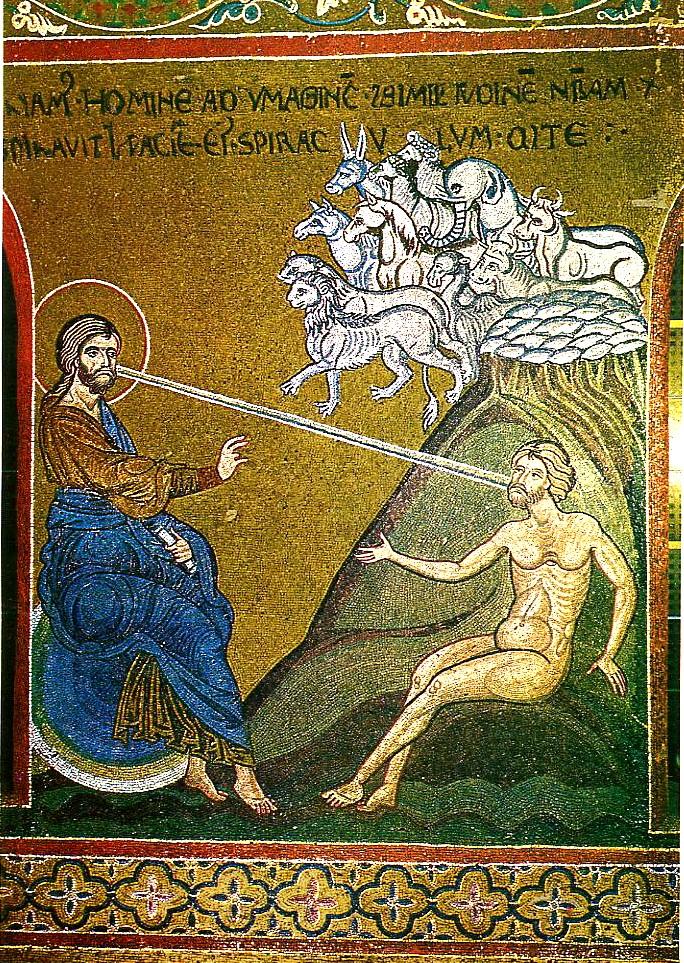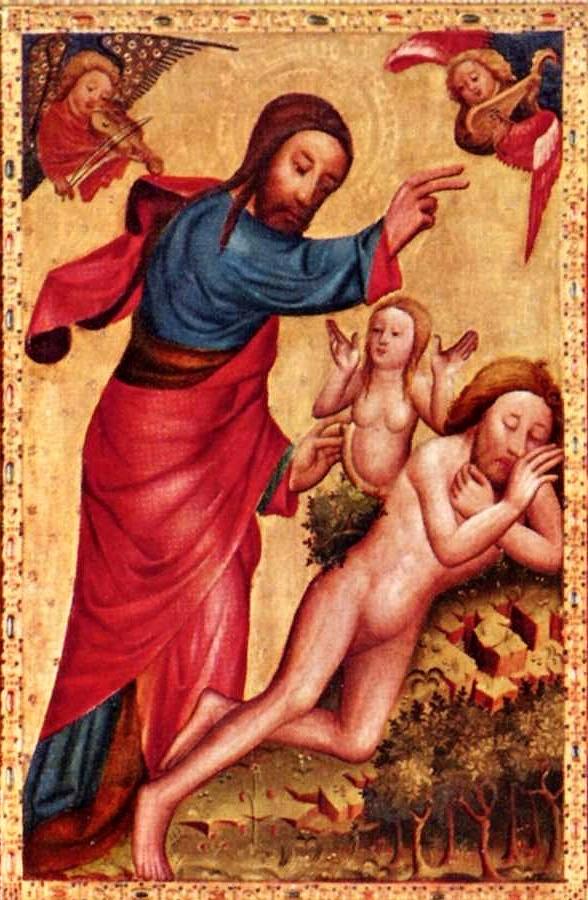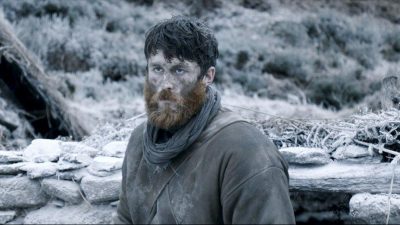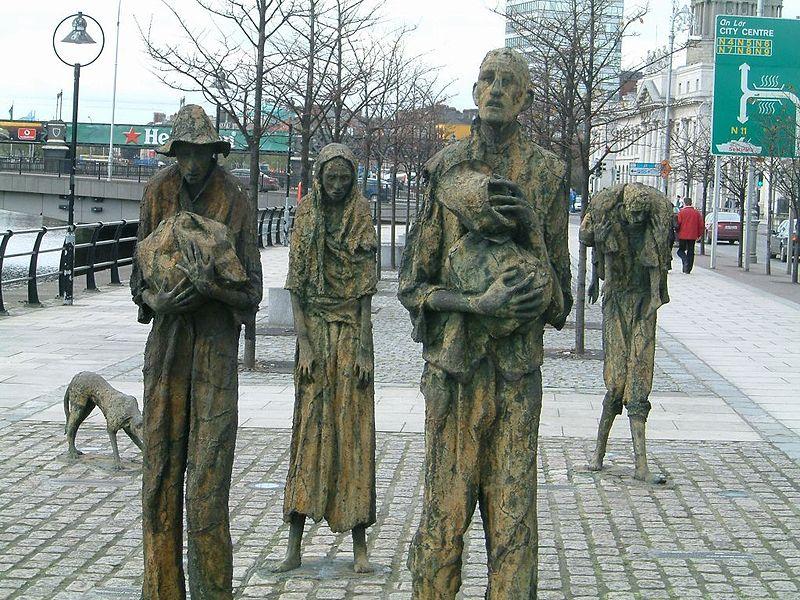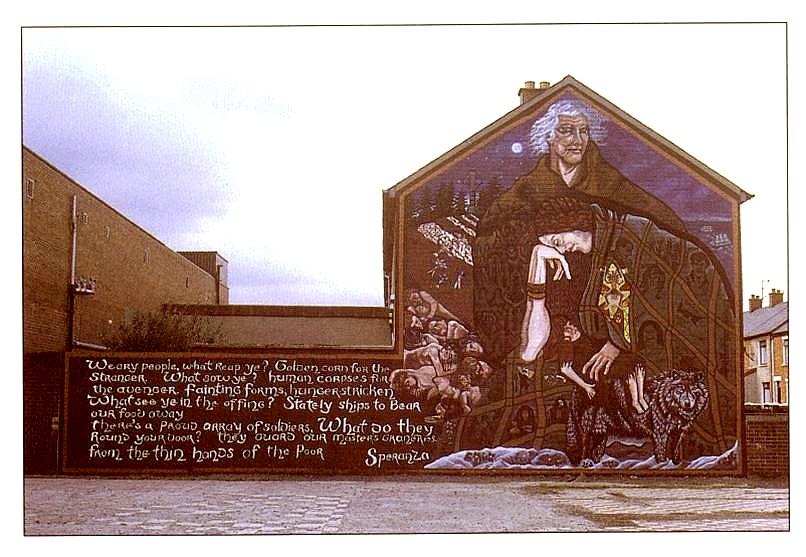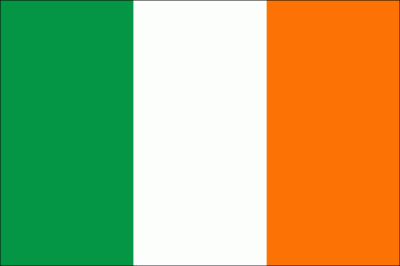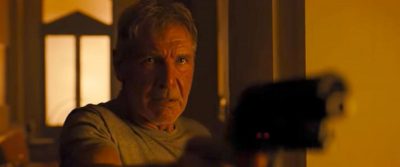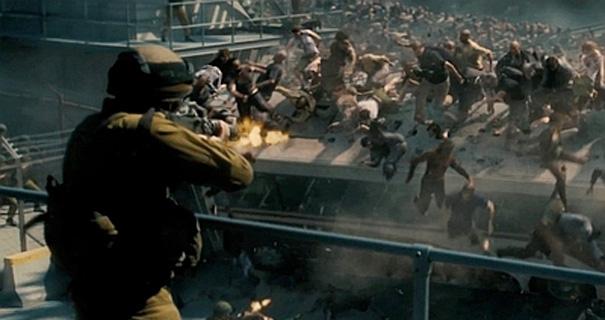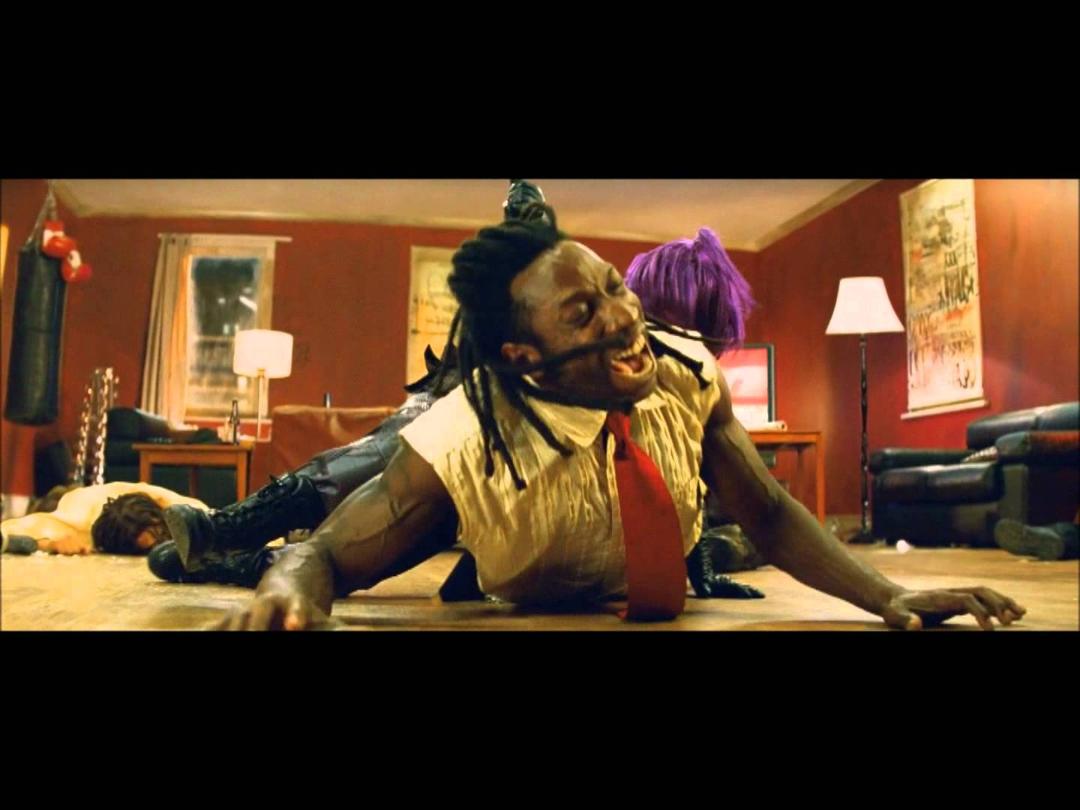“And the land, hitherto a common possession like the light of the
sun and the breezes, the careful surveyor now marked out with
long-drawn boundary lines. Not only were corn and needful foods demanded
of the rich soil, but men bored into the bowels of the earth, and the
wealth she had hidden and covered with Stygian darkness was dug up, an
incentive to evil. And now noxious iron and gold more noxious still were
produced: and these produced war – for wars are fought with both – and
rattling weapons were hurled by bloodstained hands.”
– (Ovid,
written around 8AD which laments humanity’s loss of its original Golden
condition [Ovid Metamorphoses, Book 1, The Iron Age]) [1]
The privatisation of property, extractivism, the necessity for
food-producing slaves and a warrior class to sustain and further extend
the aims of the elites are all neatly summed up in this quote from Ovid.
What is noticeable and notable is that over the millennia very little
has changed in substance. We still have today wage slaves, standing
armies, extractivism and industrialised agriculture that is oriented and
controlled according to the aims and agendas of a warmongering elite.
However, it seems that things were not always thus.
The coming of the Kurgan peoples across Europe from c. 4000 to 1000
BC is believed to have been a tumultuous and disastrous time for the
peoples of Old Europe. The Old European culture is believed to have
centred around a nature-based ideology that was gradually replaced by an
anti- nature, patriarchal, warrior society. According to the
archaeologist and anthropologist,
Marija Gimbutas:
“Agricultural peoples’ beliefs concerning sterility and
fertility, the fragility of life and the constant threat of destruction,
and the periodic need to renew the generative processes of nature are
among the most enduring. They live on in the present, as do very archaic
aspects of the prehistoric Goddess, in spite of the continuous process
of erosion in the historic era. Passed on by the grandmothers and
mothers of the European family, the ancient beliefs survived the
superimposition of the Indo-European and finally the Christian myths.
The Goddess-centred religion existed for a very long time, much longer
than the Indo-European and the Christian (which represent a relatively
short period of human history), leaving behind an indelible imprint on
the Western psyche.” [2]
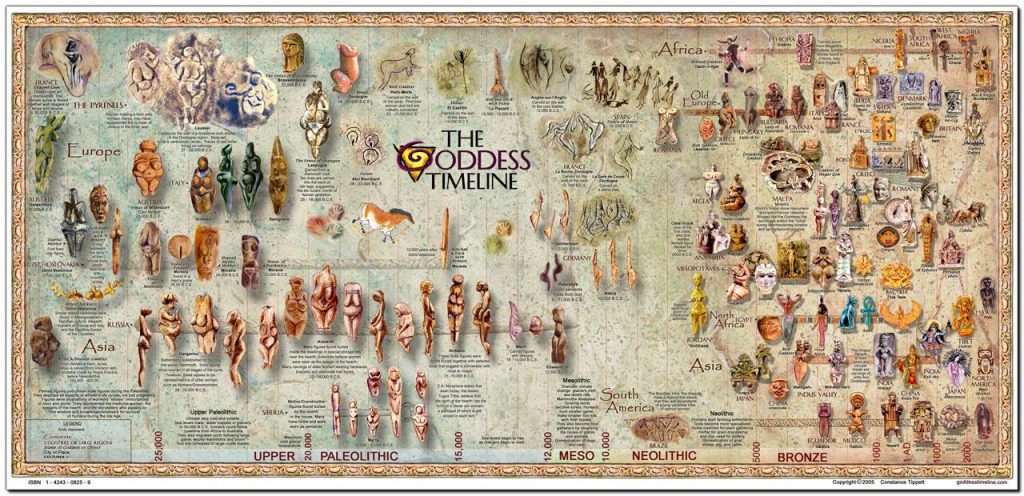
The Goddess Timeline
Click image to enlarge: A chronological record of archaeological images of women and goddesses on a uniform time scale from 30,000 BCE to the present.
Gimbutas notes that it was at this time that a relatively homogeneous pre-Indo-European Neolithic culture in southeastern
Europe was
“invaded and destroyed by horse-riding pastoral nomads from the
Pontic-Caspian steppe (the “Kurgan culture”) who brought with them
violence, patriarchy, and Indo-European languages”. While this model has
been disputed over the years recent research has broadened and deepened
our understanding of these movements.
In 2015 an international team of researchers conducted a genetic study which backs the Kurgan
hypothesis,
that “a massive migration of herders from the Yamna culture of the
North Pontic steppe (Russia, Ukraine and Moldavia) towards Europe which
would have favoured the expansion of at least a few of these
Indo-European languages throughout the continent.”
Another disputed aspect of the
hypothesis is the ‘how’- whether “the indigenous cultures were peacefully amalgamated or violently displaced.”
However, the representations of weapons engraved in stone, stelae, or
rocks appear after the Kurgan invasions as well as “the earliest known
visual images of Indo-European warrior gods”. [3] The beginning of
slavery is also seen to be linked to these armed invasions.
According to
Riane Eisler, archaeological evidence
“indicate that in some Kurgan camps the bulk of the female population
was not Kurgan, but rather of the Neolithic Old European population.
What this suggests is that the Kurgans massacred most of the local men
and children but spared some of the women who they took for themselves
as concubines, wives, or slaves.”[4] Gimbutas believed that the pre
Kurgan society of Old Europe was a “gylanic [sexes were equal],
peaceful, sedentary culture with highly developed agriculture and with
great archtectural, sculptural, and ceramic traditions” which was then
replaced by patriarchy; patrilineality; small scale agriculture and
animal husbandry”, the domestication of the horse and the importance of armaments (bow and arrow, spear and dagger).[5]
“Not so th’ Golden Age, who fed on fruit,
Nor durst with bloody meals their mouths pollute.
Then birds in airy space might safely move,
And tirn’rous hares on heaths securely rove:
Nor needed fish the guileful hooks to fear,
For all was peaceful; and that peace sincere.
Whoever was the wretch, (and curs’d be he
That envy’d first our food’s simplicity!)
Th’ essay of bloody feasts on brutes began,
And after forg’d the sword to murder man.”
-Ovid Metamorphoses Book 14
The idea of a fall, the end of a Golden Age is a common theme in many ancient cultures around the world.
Richard Heinberg, in
Memories and Visions of Paradise,
examines various myths from around the world and finds common themes
such as sacred trees, rivers and mountains, wise peoples who were moral
and unselfish, and in harmony with nature and described heavenly and
earthly paradises.
In another book,
The Fall: The Insanity of the Ego in Human History and the Dawning of a New Era,
Steve Taylor takes a psychological approach to the concept of the Fall
examining what he calls the new human psyche and the Ego Explosion
(which created a lack of empathy between human beings) and resulted in
our alienation from nature while making us both self and globally
destructive.
However,
James DeMeo takes a more radical approach in his book,
Saharasia: The 4000 BCE Origins of Child Abuse, Sex-Repression, Warfare and Social Violence in the Deserts of the Old World.
He believes that climatic changes caused drought, desertification and
famine in North Africa, the Near East, and Central Asia (collectively
Saharasia) and this trauma caused the development of patriarchal,
authoritarian and violent characteristics.
God creates Man
“Then the LORD God formed a man from the
dust of the ground and breathed into his nostrils the breath of life,
and the man became a living being.” (Gen 2:7)
Author unknown, Creation of Adam, Byzantine mosaic in Monreale, 12th century.
The arrival of violent, enslaving tribes and of a supreme male deity
led to the eventual demise of the of the female deities through demotion
or destruction of temples and statues.[6] Over time, the many
traditions of pre-patriarchal nature worship were destroyed (such as
cutting down sacred trees) or eventually assimilated into the new
patriarchal religions.[see my
Christmas article]
Thus many of the nature-based ideas of matriarchal religion were turned
on their head as the male deity creates man and Adam gives birth to
Eve.
Adam ‘gives birth’ to Eve
“For man did not come from woman, but woman from man” (1 Corinthians 11:8)
From: Master Bertram, Grabow Altarpiece, 1379-1383
In Christianity the rulers had a religion that assured their
objectives. The warring adventurism of the new rulers needed soldiers
for their campaigns and slaves to produce their food and mine their
metals for their armaments and wealth. Thus, Christ was portrayed as
Martyr and Master. In his own crucifixion as Martyr he provided a brave
example to the soldiers and as Master he would reward or punish the
slaves according to how well they had behaved.
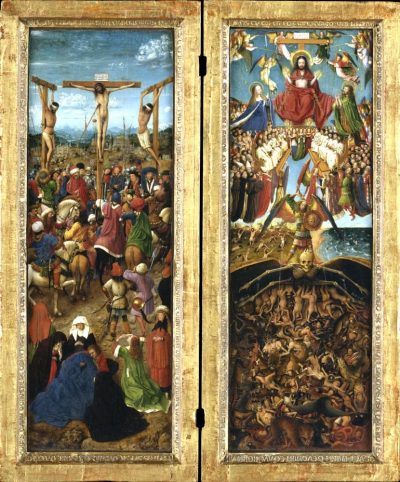 Featured image: Jan van Eyck (before c. 1390 – 9 July 1441) Crucifixion and Last Judgement diptych, c. 1430–1440. Metropolitan Museum of Art, New York
Featured image: Jan van Eyck (before c. 1390 – 9 July 1441) Crucifixion and Last Judgement diptych, c. 1430–1440. Metropolitan Museum of Art, New York
Christianity, according to
Helen Ellerbe,
“has distanced humanity from nature. As people came to perceive God as a singular supremacy detached from the physical world, they lost their reverence for nature. In Christian eyes, the physical world became the realm of the devil. A society that had once celebrated nature through seasonal festivals began to commemorate biblical events bearing no connection to the earth. Holidays lost much of their celebratory spirit and took on a tone of penance and sorrow. Time, once thought to be cyclical like the seasons, was now perceived to be linear. In their rejection of the cyclical nature of life, orthodox Christians came to focus more upon death than upon life.”[7]
Pagan festivals chart:

[From The Dark Side of Christian History, Helen Ellerbe]
"Then God said, “Let us make humankind in our image, according to our likeness; and let them have dominion over the fish of the sea, and over the birds of the air, and over the cattle, and over all the wild animals of the earth, and over every creeping thing that creeps upon the earth.”
So God created humankind in his image,
in the image of God he created them;
male and female he created them.
God blessed them, and God said to them, “Be fruitful and multiply, and fill the earth and subdue it; and have dominion over the fish of the sea and over the birds of the air and over every living thing that moves upon the earth.” "
(Genesis 1:26-28)
According to Fred Magdoff and Chris Williams:
"A rigidly anthropocentric view stemming from biblical conceptions of the domination of nature and placement of earth at the service of humans holds that humans are not only the center and most important part of life on Earth but sit at the apex of biological development. It is therefore our right to dominate and exploit the rest of nature. This view is a complete misunderstanding of the science of evolution and ecology. However distantly, all living organisms are connected to one another through evolution. We are one of an estimated 8.7 million species living on Earth. Even among mammals, Homo sapiens is only one of more than 5,000 species."
Creating an Ecological Society: Toward a Revolutionary Transformation by Fred Magdoff and Chris Williams (2017) p.158
Christian eschatology
Christian eschatology (study concerned with the ultimate destiny of
the individual soul and the entire created order) and the idea of linear
time took over from the people’s strong connection with nature and the
ever-changing seasons. Although, in early medieval times, according to
David Ewing Duncan in
The Calendar, the peasants still lived and
died “in a continuous cycle of days and years that to them had no
discernible past or future.”[8] Different seasonal festivals such as
the solstice, the Nativity, Saturnalia, Yuletide, the Easter hare and
Easter eggs etc.all had pre Christian connections but old habits died
hard and left the church no choice but to incorporate some aspects of
them into their own traditions over time.
Feminism vs class
While some aspects of the culture of prehistory are with still with
us today, interpretation of the artefacts from archaeological digs has
always been open to controversy. For example,
Cynthia Eller in her book
The Myth of Matriarchal Prehistory: Why An Invented Past Will Not Give Women a Future believes that the theory of a prehistoric
matriarchy (female rulership) was “developed in 19th century scholarship and was taken up by 1970s second-wave feminism following
Marija Gimbutas.” However, the feminist historian
Max Dashu notes that Eller
“makes no distinction between scholarly studies in a wide
range of fields and expressions of the burgeoning Goddess movement,
including novels, guided tours, market-driven enterprises. All are
conflated all into one monolithic ‘myth’ devoid of any historical foundation.”
The important point here is that ideas of matriarchal prehistory have
been used in feminist theory to blame men for war and violence today
(ignoring Thatcher and May). Sure, men have been dominant in the warring
elites but many, many more men were caught up in the enslaved soldiers,
miners and farmers classes. And as it was violence that was used to
enslave them in the first place historically, then surely it would be no
surprise if violence is used by them in the fight back against their
slavery (class struggle).
The reappraisal of our ancient past and our relationship with nature
has become an urgent necessity as climate chaos occupies more and more
of our time and energy. It is not too late to learn from the myths of
the Golden Age and Ovid’s ancient complaints to create a better future.
“This let me further add, that Nature knows
No steadfast station, but, or ebbs, or flows:
Ever in motion; she destroys her old,
And casts new figures in another mould.”
-Ovid, Metamorphoses Book 15
Caoimhghin Ó Croidheáin is an Irish artist, lecturer and writer. His artwork consists
of paintings based on contemporary geopolitical themes as well as Irish
history and cityscapes of Dublin. His blog of critical writing based on
cinema, art and politics along with research on a database of Realist
and Social Realist art from around the world can be viewed country by
country at http://gaelart.blogspot.ie/. He is a frequent contributor to Global Research.
Notes
[1] From Memories and Visions of Paradise: Exploring the Universal Myth of a Lost Golden Age by Richard Heinberg (1989)
[2] The
Language of the Goddess: Unearthing the Hidden Symbols of Western
Civilization, by Marija Gimbutas / Joseph Campbell (2001), pxvii.
[3] The Chalice and the Blade, Riane Eisler (1998) p49.
[4] The Chalice and the Blade, Riane Eisler (1998) p49.
[5] The
Language of the Goddess: Unearthing the Hidden Symbols of Western
Civilization, by Marija Gimbutas / Joseph Campbell (2001), pxx.
[6] See: When God Was a Woman, Merlin Stone (1978) pps66-67.
[7] The Dark Side of Christian History, Helen Ellerbe (1995) p139
[8] The
Calendar: The 5000-year Struggle to Align the Clock and the Heavens –
and What Happened to the Missing Ten Days, David Ewing Duncan (2011)
p137.
